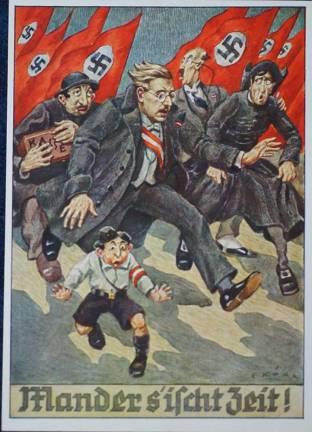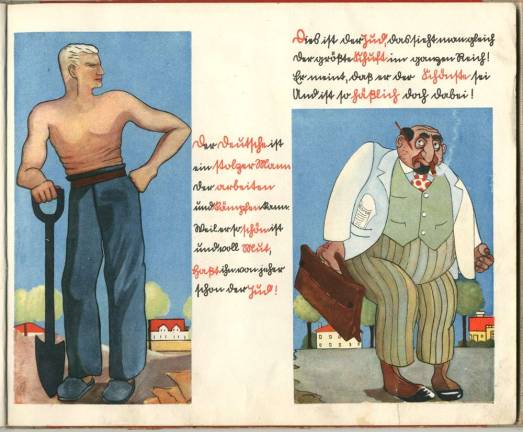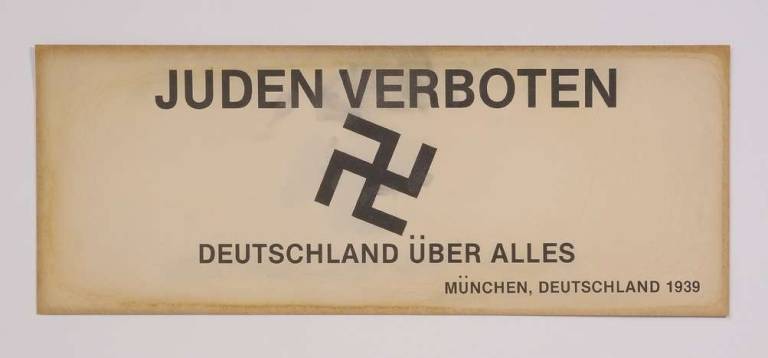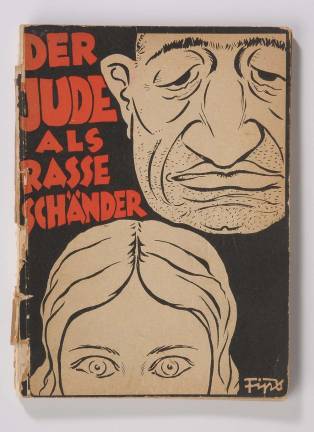“The Holocaust museums and memorials miss the point,” said Kenneth Rendell, who has loaned objects from his collection to the New-York Historical Society for a chilling exhibition tracing anti-Semitism in Germany from 1919-1939. Rendell, the founder and director of the World War II Museum in Boston, explained that focusing only on what happened to the Jews during the Shoah is vital, but that it is only a part of the story.
It’s the old frog-in-the-water problem: While there were many accomplished Jewish lawyers, doctors and other professionals in Germany well before World War II, there was also an undercurrent of Jew hatred. Hitler stoked existing prejudices, indoctrinating other German citizens to consider Jew-hating as acceptable and normal.
Rendell emphasized that Hitler mass-marketed anti-Semitism in the guise of nationalism. In the wake of the German Reich’s humiliating defeat in World War I, Hitler coined slogans like “Germany awake” and “Bring back Germany.”
The exhibit’s 61 objects, among them pamphlets, signs and newspaper clippings, are on display in a small, dimly lit room. One of the earliest shows Hitler’s handwritten comments on a copy of the Versailles Treaty printed in a newspaper. “The peace treaty aims at preparing Germany for the Jewish dictate,” Hitler wrote in the margins. “The Jews must therefore leave Germany.”
Also on view are three-dimensional objects, such as a cane handle and ashtrays depicting Jewish stereotypes. Runaway inflation was blamed on the Jews, and in 1932, banknotes were overprinted to make them Nazi propaganda leaflets. A coloring book, possibly meant for children, consisted of 25 full-page caricatures of Jewish men.
There’s also a book that warned children that a mushroom might look pleasant enough but prove poisonous. The mushroom, of course, stands in for a Jew.
The 1920 program of the Nazi Party announced goals of segregating Jews and abrogating their political, legal and civil rights. It also declared that “no Jew can be a member of the German nation.”
For Rendell, the importance of his museum and its educational programs, and of the Historical Society’s exhibit, is to get people to understand “how easy it is to be against people if you don’t know anything about them.” Some people, dissatisfied with the way things are, might blame others when they speak out, he continued, “but there are evil people and they use this disaffection. It’s hard for good people to appreciate the danger.”
When asked if what’s on view at the Historical Society echoes political discourse this election season, Rendell reserves comment, citing the nonpartisan nature of his museum.
The exhibit’s curator, Marilyn Kushner, said perhaps the most important document in the exhibit is the 1939 manuscript in Hitler’s handwriting, where he outlined the speech delivered to the Reichstag on Jan. 30, 1939. Hitler wrote that “Europe will not have peace until the Jewish question has been disposed of,” and that if there is a world war, it will result in “the annihilation of the Jewish race in Europe.” Kushner said the speech represents the climax of Hitler’s indoctrination of the German people and the steady erosion of Jewish rights.
Even those familiar with the Holocaust’s history might be astounded at how determined Hitler was, and how early he started his campaign. The series of measures were incremental, excluding Jews from public life, even going so far as forbidding Jews to use the same park benches as “Aryans.” Eventually all contact between Jews and other Germans was prohibited.
Rendell pointed out that anti-Semitism in the 1930s was a phenomenon that took root worldwide, including in the United States. “People forget that Henry Ford was an anti-Semite, and that Father Coughlin had a radio program with millions of listeners” that spewed Jew hatred, he said of a Roman Catholic priest who hosted a weekly national broadcast. There were also “gentlemen’s agreements” and “restricted” establishments. And history records that Breckenridge Long, the State Department official in charge of European refugee affairs during World War II, obstructed rescue attempts and drastically restricted immigration.
Louise Mirrer, the Historical Society’s president, noted that recent terrorist attacks targeting Jewish communities in Europe and elsewhere demonstrate that the current exhibit is all too relevant.
Meanwhile, anti-Muslim, anti-immigrant, anti-government and anti-woman rhetoric show all too clearly that hatred of “the other” isn’t limited to anti-Semitism. Sara Lipton, a Stony Brook University history professor who lives on the Upper West Side, said it was important to acknowledge the centuries-old history of anti-Semitism. But, she emphasized, ”that doesn’t mean violence is inevitable.”
There are everywhere suspicions and even hatred of “the other,” but these can be dissipated and controlled until specific conditions come into play and latent ideas are inflamed, she said. “There is more likely to be violence,” she continued, “when propaganda and rhetoric come into the picture.” In her book, “Dark Mirror,” Lipton writes about the power of visual imagery and how it can stoke embryonic sentiments. Pointing to the experience of the Jews in medieval Europe, Lipton said that “as long as the teachings of Christianity focused on Jesus as transcending death, their labeling Jews as the killers of Christ didn’t incite violence. It was when heightened rhetoric, including crusade and Easter preaching stirred up rage about the crucifixion that armed bands turned to anti-Jewish action.”
Words matter, Lipton emphasized. And “when they are vicious and repeated and accompanied by powerful imagery, they may push specific buttons.”
When does talk cross a line? Some of the political rhetoric tossed around these days engages “a segment of American society that believes they used to be dominant and respected,” Lipton said. “They believe that they are being displaced, and that’s why what’s being said resonates with them. Those passions can break down order. They are dangerous and violent. Once a wave of passion takes over, others can get swept away.”



